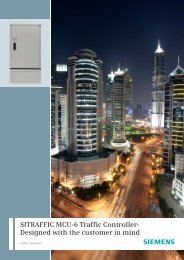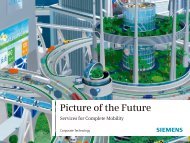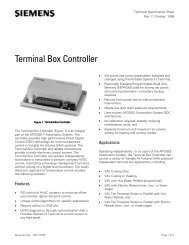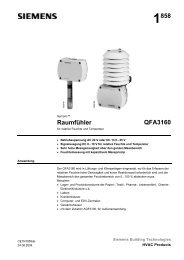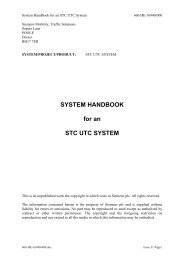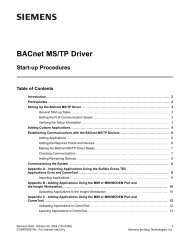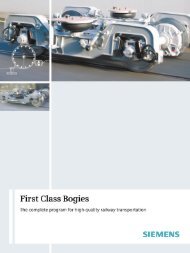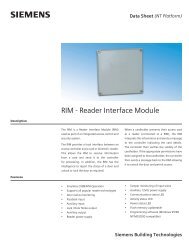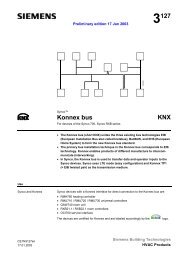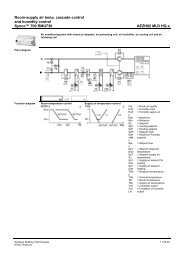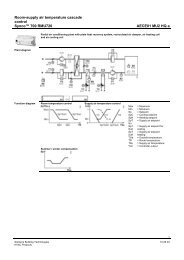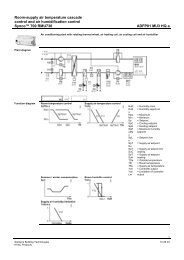A nifty means of transport and mobile electrical storage ... - Siemens
A nifty means of transport and mobile electrical storage ... - Siemens
A nifty means of transport and mobile electrical storage ... - Siemens
You also want an ePaper? Increase the reach of your titles
YUMPU automatically turns print PDFs into web optimized ePapers that Google loves.
s<br />
The future is electric, clean <strong>and</strong> quiet<br />
A <strong>nifty</strong> <strong>means</strong> <strong>of</strong> <strong>transport</strong> <strong>and</strong> <strong>mobile</strong> <strong>electrical</strong> <strong>storage</strong><br />
device in one: E-cars pick up speed<br />
Society, industry <strong>and</strong> politics can no longer ignore the subject <strong>of</strong><br />
electromobility, especially in view <strong>of</strong> the continuing problems posed by climate<br />
change, rising fuel prices <strong>and</strong> the global sales crisis in the automotive market.<br />
So there are good reasons why the idea <strong>of</strong> <strong>electrical</strong>ly driven vehicles is now<br />
being revived over a 100 years since they were first tested. New technical<br />
developments – in drive technology <strong>and</strong> batteries, for example – are imparting a<br />
further boost. However, this topic is also giving rise to totally new business<br />
segments <strong>and</strong> alliances that pose challenges for automotive manufacturers <strong>and</strong><br />
suppliers, the energy industry <strong>and</strong> policymakers. There is the question <strong>of</strong><br />
creating the necessary infrastructures (smart grids) as well as production <strong>and</strong><br />
“refueling”. They dem<strong>and</strong> innovative solutions: For instance, the electric<br />
vehicles should be able to store <strong>and</strong> return energy – <strong>and</strong> so act as load sinks in<br />
the event <strong>of</strong> overcapacities <strong>and</strong> also as sources <strong>of</strong> energy to help cope with<br />
peak loads in the network. <strong>Siemens</strong> addresses this trend with its ecological<br />
commitment <strong>and</strong> portfolio <strong>of</strong> products <strong>and</strong> solutions for electro<strong>mobile</strong><br />
applications.<br />
The automotive industry, associations <strong>and</strong> policymakers predict a thriving future for<br />
electromobility in general <strong>and</strong> specifically for the electric car. Under the German<br />
government’s “National Electromobility Development Plan”, more than a million<br />
electric vehicles are to be on the road in Germany alone by 2020 – a noble objective<br />
given that the technology is more than a 100 years old. Nevertheless, developers <strong>and</strong><br />
industry have yet to come up with a vehicle that is suitable for everyday use. That’s<br />
because up to now the batteries have simply been too expensive <strong>and</strong> heavy for mass<br />
production.<br />
Despite research into alternative propulsion concepts, such as hydrogen <strong>and</strong> fuel<br />
cells, development <strong>of</strong> <strong>storage</strong> technologies for electric drives continued. And with<br />
pleasing results – after all, all large manufacturers are now busy designing such<br />
vehicles <strong>and</strong> making them suitable for mass production <strong>and</strong> use. The first results<br />
were recently presented to the public, for instance at the Geneva Auto Salon or the<br />
IAA motor show in Frankfurt. Daimler, for example, is planning series production <strong>of</strong> an<br />
electric version <strong>of</strong> its Smart microcar as <strong>of</strong> 2012 <strong>and</strong> is aiming for tens <strong>of</strong> thous<strong>and</strong>s to<br />
roll <strong>of</strong>f the belt every year. The battery will be rechargable from a simple mains socket<br />
<strong>and</strong> enable a range <strong>of</strong> 115 kilometers.<br />
Intelligent <strong>and</strong> environmentally friendly: A rosy – <strong>and</strong> green – future<br />
The government’s goal <strong>of</strong> a million electric cars on German roads in ten years’ time<br />
happily <strong>means</strong> the additional electricity required will rise only slightly, according to the<br />
1
s<br />
country’s Renewable Energy Federation (BEE). This extra consumption can even be<br />
covered without problems through the growth in renewable energies. For example:<br />
Electricity generated from renewable energies increased from 2007 to 2008 by some<br />
4.3 billion kilowatt-hours – more than twice the total consumption by the electric car<br />
fleet forecast by the government in 2020.<br />
However, there is the further challenge <strong>of</strong> developing workable business models for<br />
the future. After all, selling electricity for electric vehicles just does not pay <strong>of</strong>f given<br />
their energy efficiency <strong>and</strong> current energy prices – especially when you also consider<br />
the enormous investments required to create the necessary infrastructure.<br />
Another focal aspect is currently a power supply system to flank everything. After all,<br />
the system <strong>of</strong> the future – the smart grid – must be intelligent <strong>and</strong> flexible, otherwise it<br />
will not be able to integrate the large volumes <strong>of</strong> fluctuating wind <strong>and</strong> solar electricity<br />
<strong>and</strong> the growing number <strong>of</strong> small, local power generators. Key technologies within<br />
these smart grids will include smart meters <strong>and</strong> virtual power plants to contribute<br />
intelligence to the medium- <strong>and</strong> low-voltage grids. They will meet future requirements<br />
as regards dynamic market activity, forecast mechanisms <strong>and</strong> quick balancing.<br />
The car as a source <strong>of</strong> revenue<br />
In general, it is always helpful to look further afield <strong>and</strong> to think about more than just<br />
the car itself when it comes to the issue <strong>of</strong> electromobility. “Looking to the near future,<br />
we have to take all possible <strong>electrical</strong>ly driven vehicles into account. Such drives<br />
already play important roles in various specialized areas, such as at warehouses or<br />
airports,” says Christian Lechler, Account Line Manager at <strong>Siemens</strong> IT Solutions <strong>and</strong><br />
Services – Industry, Energy, Healthcare. “As far as cars <strong>and</strong> trucks are concerned,<br />
the purely electric drive is not all that important at present – unlike the hybrid-electric<br />
drive.”<br />
“A key factor in our commitment is for our developments <strong>and</strong> <strong>of</strong>fers to keep pace with<br />
how society thinks <strong>and</strong> acts green,” notes Markus Zahnjel, head <strong>of</strong> the Car<br />
Electronics Automotive segment at <strong>Siemens</strong> IT Solutions <strong>and</strong> Services. “We mainly<br />
focus on applications that relate to driving, but also ones above <strong>and</strong> beyond that. One<br />
example is the use <strong>of</strong> vehicles or entire fleets as load sinks, i.e. a sort <strong>of</strong> electricity<br />
store: When there is too much energy in the grid, it can be delivered to the<br />
electro<strong>mobile</strong>s. If the vehicles no longer require it or need a lower quantity at a<br />
specific time, the energy can be fed back into the grid, possibly even at a pr<strong>of</strong>it to the<br />
car owners, for example if there happens to be a shortage <strong>of</strong> electricity. Existing fleets<br />
where uniform conditions predominate are currently suitable for such energy<br />
brokering models. However, commuters with their set routes <strong>and</strong> times at which they<br />
travel, as well as second cars, which are normally not used for long trips, are potential<br />
targets.”<br />
The basis for such models is networking <strong>of</strong> the vehicles with the infrastructure – for<br />
instance the smart grid, which can also be used as a tool for communication. Thanks<br />
to them, the e-cars are informed <strong>of</strong> the current electricity price by the network<br />
2
s<br />
operator <strong>and</strong> then decide independently whether to buy or supply it, i.e. feed it back<br />
into the grid – naturally always taking into account the distance left to travel <strong>and</strong> the<br />
battery power required for it. It is also conceivable for tomorrow’s e-cars to utilize the<br />
information in the vehicle owner’s calendar or the destination in the navigation device<br />
to decide on the best strategy.<br />
“Charge her up, please”<br />
What is now needed is innovative ideas <strong>and</strong> actions, with a focus on further feasible<br />
<strong>and</strong> potential components that will make a business model for electromobility<br />
workable worldwide. Zahnjel has a quick response to how using vehicles as load<br />
sinks when there is too much energy in the grid <strong>of</strong>fers further benefits apart from the<br />
monetary aspect: “Renewable sources, such as wind <strong>and</strong> solar power, deliver energy<br />
only on an irregular basis, which makes forecasting difficult. Electric cars with<br />
batteries are a highly promising <strong>means</strong> <strong>of</strong> being able to buffer or store surplus<br />
capacities.” The power grid itself cannot assume this function since it is a finely<br />
balanced system in which supply <strong>and</strong> dem<strong>and</strong> must always be exactly in equilibrium,<br />
otherwise the frequency <strong>of</strong> the alternating voltage deviates from the prescribed 50<br />
hertz: It falls when dem<strong>and</strong> is too high <strong>and</strong> increases when there is an excess supply.<br />
That would result in damage to the connected consumers, such as PCs, machines,<br />
motors or generators.<br />
The following situation illustrates why such load sink models are a sensible<br />
alternative: Excess supply is a problem because German network operators are<br />
compelled under the Renewable Energy Act to give preference to electricity from<br />
renewable sources when feeding power into their grid. If there is a large supply <strong>of</strong><br />
renewable energy, conventional power plants have to be shut down.<br />
The upshot may be grotesque consequences. If there is too much wind, the surplus<br />
energy must be dumped at giveaway prices on Leipzig Energy Exchange – in the<br />
worst case at a negative price. However, some operators prefer to accept that rather<br />
than submit to the high cost <strong>and</strong> effort <strong>of</strong> shutting down their plant. This is where ecars<br />
come in: If they are connected by cable to the power grid, their batteries can be<br />
used as local buffer stores. Although their <strong>storage</strong> capacity is small compared with<br />
the amount <strong>of</strong> energy required in the grid, this shortcoming can quickly be made good<br />
thanks to their large number <strong>and</strong> current conduction with a power <strong>of</strong> up to 40 kW with<br />
3-phase charging per vehicle.<br />
Electric is now trendy – <strong>and</strong> green is the icing on the cake<br />
For decades, the car has been the object <strong>of</strong> a wide range <strong>of</strong> technical innovations <strong>and</strong><br />
above all the pride <strong>and</strong> joy <strong>of</strong> Germans. Now there is further potential as a result <strong>of</strong><br />
electromobility: Green <strong>and</strong> lifestyle aspects are gaining in importance as an incentive<br />
to buy e-cars. “The image <strong>of</strong> e-cars as sluggish, slow <strong>and</strong> ugly no longer holds true.<br />
Solely in terms <strong>of</strong> driving dynamics <strong>and</strong> acceleration, conventional gasoline-powered<br />
vehicles have long since ceased to be a match for e-cars in towns <strong>and</strong> cities. The<br />
new electric motorcycles, for instance, accelerate noiselessly from 0 to 50 in two<br />
3
s<br />
seconds,” states Zahnjel. “What’s more, you spare the environment – a factor that is<br />
increasingly swaying more <strong>and</strong> more customers. And, <strong>of</strong> course, it’s far cheaper<br />
driving on electricity than gasoline.”<br />
As regards the technology required for electro<strong>mobile</strong> models suitable for everyday<br />
use, most <strong>of</strong> it already exists <strong>and</strong> can be implemented. “The hardware is ready for<br />
use, even though prices still need to be squeezed down. The main challenges are to<br />
develop <strong>and</strong> implement a financially tenable business model <strong>and</strong> to interconnect the<br />
different systems. The fact is that a practicable overall e-car system st<strong>and</strong>s or falls by<br />
the integrated solution concepts that exist <strong>and</strong> not by the individual hardware<br />
components which various manufacturers put on the market at regular intervals,” is<br />
the consideration raised by energy expert Lechler.<br />
The conditions are therefore clearly defined. Now industry <strong>and</strong> policymakers must do<br />
their homework to prevent the e-car hype from bursting like a bubble – as has been<br />
the case with many other developments once feted as revolutionary – <strong>and</strong> passing<br />
the high-tech location <strong>of</strong> Germany by. “There is now a good foundation in the shape<br />
<strong>of</strong> a number <strong>of</strong> global funding programs,” reports Zahnjel. “They focus on research<br />
into the vehicles themselves, i.e. components, electric motor batteries or power<br />
electronics. There is also a series <strong>of</strong> field trials that for the first time are investigating<br />
<strong>and</strong> testing interaction between vehicles <strong>and</strong> the infrastructure <strong>and</strong> the underlying<br />
business models.”<br />
Lechler adds: “Basically, what we’re looking for at the moment is a real all-round<br />
talent. Nevertheless, the day will soon come within these many complex projects<br />
when all the general conditions are right <strong>and</strong> a feasible business case emerges.” It is<br />
not just customers who benefit from these developments, but also the chemicals<br />
industry (battery development) <strong>and</strong> <strong>of</strong> course the <strong>electrical</strong> engineering industry,<br />
automotive manufacturers <strong>and</strong> suppliers, utilities <strong>and</strong>, last but not least, the service<br />
sector – <strong>and</strong> that also includes IT service providers like <strong>Siemens</strong> IT Solutions <strong>and</strong><br />
Services.<br />
Basic infrastructure work: Electromobility in the smart grid<br />
Before the quiet <strong>and</strong> eco-friendly speedsters become a common sight on the roads,<br />
quite a bit still has to be done as regards the infrastructure for e-mobility.<br />
Interdisciplinary thinking across sectors is called for. After all, if we want<br />
electro<strong>mobile</strong>s to be available everywhere, at low-cost <strong>and</strong> suitable for mass use, we<br />
not only need a drive that works, but also an infrastructure to match: Only then will the<br />
vision become reality. “The infrastructures are crucial to success,” is Lechler’s<br />
conviction. “It’s not enough to create business models where electricity is sold at the<br />
pump like now at conventional service stations. That’s because the vehicles require<br />
only a very low amount <strong>of</strong> electricity, whereas the fueling process itself consumes a<br />
great deal <strong>of</strong> power. However, according to current estimates, power consumption –<br />
assuming a million electric vehicles on Germany’s roads – will increase by a mere<br />
one percent. That <strong>means</strong> selling electricity only to e-cars will not be a pr<strong>of</strong>itable<br />
business for utilities <strong>and</strong> also <strong>of</strong>fers too small an incentive for other sectors to invest.”<br />
4
s<br />
There are other challenges: The objective is to enable electro<strong>mobile</strong>s to be recharged<br />
anywhere – at the garage, the supermarket or <strong>of</strong>fice parking lot. A service provider is<br />
to bill for the electricity used. However, that can only work if every vehicle is identified<br />
unambiguously <strong>and</strong> all the data is exchanged securely <strong>and</strong> in real time between the<br />
on-board electronics <strong>and</strong> pump.<br />
Recent figures from the German Renewable Energy Federation (BEE) show what<br />
inroads renewable energies have made into everyday life in Germany: Almost every<br />
one-in-ten kilowatt-hour consumed in Germany in 2008 was generated from<br />
renewable energy (9.6 percent <strong>of</strong> total energy consumption). The positive effects <strong>of</strong><br />
renewable energies are particularly clear in economic terms: Last year alone, the cost<br />
<strong>of</strong> importing fuel was able to be reduced by 7.8 billion euros as a result. Moreover, the<br />
external costs for damage to the climate, environment <strong>and</strong> health as a result <strong>of</strong> power<br />
generation fell by 9.2 billion euros. “That <strong>means</strong> renewable energies reduced the<br />
financial burden on the economy <strong>and</strong> consumers by 17 billion euros last year,”<br />
calculates the BEE’s President Dietmar Schütz – a figure matching that for the first<br />
Economic Stimulus Package adopted by the German government in December 2008.<br />
Trends in the individual segments in the renewable energy sector in 2008:<br />
Power generation<br />
The power generated from renewable energy rose last year to 15.3 percent <strong>of</strong><br />
Germany’s total electricity supply (2007: 14.5%). Compared with 2007, the amount <strong>of</strong><br />
electricity produced from renewable resources increased from 89.6 to 95.1 billion<br />
kWh, or by 6.1%. Most <strong>of</strong> this – 40.3 billion kWh – again came from wind power<br />
(2007: 39.7), followed by bioenergy, which accounted for some 28.7 billion kWh<br />
(2007: 25.7). Hydroelectric power supplied 21.8 billion kWh (2007: 21.2).<br />
Photovoltaics contributed 4.3 billion kWh to the power generated in Germany, an<br />
increase <strong>of</strong> 40 percent over 2007 <strong>and</strong> by far the strongest growing segment. As in the<br />
previous year, geothermal energy made a contribution <strong>of</strong> 4 million kWh.<br />
Heat generation<br />
The share <strong>of</strong> heat supplied by renewable sources in Germany rose to 7.3 percent<br />
(2007: 6.8%). Heat generated from bioenergy, solar power <strong>and</strong> geothermal energy<br />
increased from 90.9 billion kWh in 2007 to 98.5 billion kWh, or by 8.4%. The lion’s<br />
share – 90.2 billion kWh – came from bioenergy (2007: 84.2). Solar power supplied<br />
5.3 <strong>and</strong> geothermal energy 3.0 billion kWh <strong>of</strong> heat in 2008, an increase <strong>of</strong> 20 <strong>and</strong> 30<br />
percent respectively over 2007.<br />
Bi<strong>of</strong>uel production<br />
The share accounted for by bi<strong>of</strong>uels in total fuel consumption slumped from 7.6<br />
percent in 2007 to 5.9 due to the discontinuation <strong>of</strong> tax breaks for biodiesel <strong>and</strong><br />
vegetable oils – a fall <strong>of</strong> 22 percent from 46.5 billion kWh in 2007 to 36.3 billion kWh.<br />
Only bioethanol recorded a significant increase: The amount <strong>of</strong> energy from it rose<br />
from 3.4 to 4.3 billion kWh.<br />
5
s<br />
Renewable energies are to cover almost half <strong>of</strong> Germany’s energy needs – 47<br />
percent – in 2020. This will also ensure a secure supply <strong>of</strong> power, even at times <strong>of</strong><br />
maximum dem<strong>and</strong>, according to the recent “Power Supply 2020“ development<br />
forecast presented by the BEE <strong>and</strong> the Renewable Energy Agency in Berlin at the<br />
beginning <strong>of</strong> 2009.<br />
The positive effects <strong>of</strong> renewable energies on climate protection, fuel imports <strong>and</strong> the<br />
labor market are considerable, according to the latest industry forecast: The sector is<br />
now making an extremely effective contribution to protecting the climate <strong>and</strong> in 2008<br />
reduced carbon dioxide emissions by almost 87 million tons alone in the area <strong>of</strong><br />
power generation. This figure is expected to increase to more than 200 million tons a<br />
year by 2020. There will be a corresponding fall in the need for fossil fuels,<br />
accompanied by a reduction in the high costs <strong>of</strong> imports <strong>and</strong> external costs for<br />
damage to the climate <strong>and</strong> environment. The savings will run into the billions <strong>and</strong> be<br />
far in excess <strong>of</strong> expenditure on exp<strong>and</strong>ing renewable energies. There will also be a<br />
positive impact on the labor market, with the number <strong>of</strong> jobs in the renewable energy<br />
sector increasing from 250,000 at present to at least 500,000 in 2020.<br />
Innovative business models with a mixed cost strategy pave the way<br />
The cars now being <strong>of</strong>fered on the market are simply far more expensive that<br />
gasoline-driven cars. That is mainly attributable to the battery, since all the other<br />
components are just as expensive, if not cheaper. A high-performance battery for<br />
<strong>electrical</strong> vehicles, for example, now costs around 10,000 euros. A mixed cost model<br />
is therefore a suitable financing model. “It would be conceivable for the vehicle itself<br />
to be a fixed price component, whereas the expensive battery technology is financed<br />
by <strong>means</strong> <strong>of</strong> energy brokering. That mean: A vehicle can not only absorb electricity,<br />
but also resell it if required, i.e. act bi-directionally as a consumer <strong>and</strong> source <strong>of</strong><br />
energy. Car owners can sell the stored energy they do not need back to the grid at a<br />
pr<strong>of</strong>it,” states Lechler.<br />
That obviously requires powerful, cutting-edge information <strong>and</strong> communications<br />
technology (ICT), primarily for the vehicle itself: Only smart solutions will enable them<br />
to be act as a load sink or a source <strong>of</strong> energy <strong>and</strong> permit billing <strong>of</strong> the used or<br />
returned electricity. One basic requirement is that the vehicle must constantly be<br />
connected to an ICT-based infrastructure responsible for h<strong>and</strong>ling the billing <strong>and</strong><br />
control processes. “We are talking here <strong>of</strong> control mechanisms that communicate with<br />
the vehicles <strong>and</strong> charging stations. However, the charging or discharging process<br />
must naturally be integrated in a billing system which can in turn be used as a basis<br />
for load forecasts for cities or their districts. These then help control the power grid,”<br />
says Zahnjel.<br />
A great challenge – <strong>and</strong> also an opportunity for <strong>Siemens</strong> IT Solutions <strong>and</strong> Services, to<br />
pioneer <strong>and</strong> help shape this innovative technology from the outset – is a smart <strong>means</strong><br />
<strong>of</strong> calculating <strong>and</strong> billing the energy that has been returned or fuelled. After all, the<br />
current model based on kilowatt-hours does not work for e-cars or is only feasible to a<br />
limited extent. The quantities are sometimes too low or can only be captured at very<br />
6
s<br />
great cost <strong>and</strong> effort for the existing electricity billing systems as we know them now<br />
to be applied expediently. “Models like the flat rates or other variants we know from<br />
telecommunications providers will be conceivable in future. We see ourselves very<br />
clearly as a provider <strong>and</strong> expert from day one because we have the industry knowhow<br />
<strong>and</strong> solution competence, for example in smart meters,” is the conviction <strong>of</strong> the<br />
automotive specialist.<br />
Changing batteries: Simple h<strong>and</strong>ling <strong>and</strong> speed are essential<br />
Yet before we can start taking about such complex billing models <strong>and</strong> they are ready<br />
to be deployed, a number <strong>of</strong> technical challenges have to be overcome – for example,<br />
the issue <strong>of</strong> changing batteries, where large <strong>and</strong> complex systems are needed <strong>and</strong><br />
high requirements relating to personal safety have to be met. Although the systems<br />
permit a rapid throughput –like fuelling today at a conventional service station – the<br />
cost <strong>and</strong> effort is huge. Moreover, changing batteries might represent a transitional<br />
solution provided battery technology is improved. However, once the infrastructures<br />
for it have been created, this complex structure will also be transformed into a simple<br />
process. “The changing stations can then be turned into fast charging stations where<br />
the batteries in the vehicle can be completely recharged in the space <strong>of</strong> five to ten<br />
minutes. Such stations are mainly focused on fleets, since mature systems with<br />
known environmental conditions predominate in them <strong>and</strong> so precise planning is<br />
possible. They also enable larger distances to be traveled,” says Lechler with an eye<br />
to the future.<br />
The EDISON (Electric vehicles in a Distributed <strong>and</strong> Integrated market using<br />
Sustainable energy <strong>and</strong> Open Networks) project in Denmark<br />
EDISON is the first <strong>and</strong> most extensive project <strong>of</strong> its type <strong>and</strong> aims to supply a vehicle<br />
pool from the mains socket with electricity generated from the fluctuating source <strong>of</strong><br />
wind power. Up to 20 percent <strong>of</strong> Denmark’s energy already comes from the<br />
thous<strong>and</strong>s <strong>of</strong> wind turbines along <strong>and</strong> <strong>of</strong>f the country’s coasts, a figure that is to be<br />
increased to 50 percent by 2050. Vehicle <strong>and</strong> grid technology will be developed <strong>and</strong><br />
advanced in the next two years so that excess electricity generated from wind power<br />
does not have to be passed on to neighboring countries at great expense. Practical<br />
testing is to commence on Bornholm in 2011. The planned bidirectional flow <strong>of</strong> energy<br />
harbors enormous potential: 200,000 vehicles connected to the grid with a power <strong>of</strong><br />
40 kWh, can quickly deliver eight gigawatts. By comparison, that is more than the<br />
normal power Germany currently needs as a cushion for peak consumption times, for<br />
example at breakfast time or in the early evening.<br />
<strong>Siemens</strong> is a member <strong>of</strong> the EDISON consortium <strong>and</strong> is responsible for the areas <strong>of</strong><br />
fast charging <strong>and</strong> battery replacement systems. Other partners are the Technical<br />
University <strong>of</strong> Denmark (DTU) <strong>and</strong> its research center, Dong Energy, Eurisco <strong>and</strong> IBM.<br />
7
s<br />
The energy business becomes an Internet business<br />
Energy expert Lechner sums up the technological requirements for the overall emobility<br />
architecture as follows: “Electro<strong>mobile</strong>s need information from the primary<br />
sources <strong>of</strong> traffic management systems <strong>and</strong> telematics solutions. Combined with user<br />
pr<strong>of</strong>iles <strong>and</strong> actual (driving) behavior, this data is merged with that from the energy<br />
management systems <strong>and</strong> aggregated to give an overall forecast at the end <strong>of</strong> the<br />
process. As a result, mobility providers can plan exactly <strong>and</strong> know when <strong>and</strong> how<br />
much energy they need for which customer.”<br />
This is almost automatically accompanied by additional business models: If the<br />
vehicle is constantly connected to the Internet or another service provider, it makes<br />
sense to <strong>of</strong>fer services above <strong>and</strong> beyond searching for a parking space <strong>and</strong><br />
information on contract repair shops. “Take, for example, the Apple App Store, an<br />
extremely successful business model that works excellently in the world <strong>of</strong> <strong>mobile</strong><br />
terminal devices. A similar scenario is likewise conceivable for a <strong>mobile</strong> terminal<br />
device like a vehicle, for instance to pay automatically for parking or to find a nearby<br />
restaurant <strong>and</strong> reserve a table right away. By <strong>of</strong>fering such services, providers can<br />
enhance their portfolio to deliver important added value that may be crucial to their<br />
success,” is Zahnjel’s conviction.<br />
A further area where work still needs to be done is to achieve global consensus on<br />
consistent st<strong>and</strong>ards for communication <strong>and</strong> models such as roaming. “There are<br />
adapters for plugs, so that is not a challenge,” notes Zahnjel. “Things get tougher<br />
when one billing system has to communicate with another. In the medium term, there<br />
are bound to be service providers for conurbations who <strong>of</strong>fer the same<br />
communications st<strong>and</strong>ards. That <strong>means</strong> the identical ICT is used in the vehicle <strong>and</strong><br />
by the service provider – <strong>and</strong> my car works just as well in Munich as in Hamburg or<br />
Paris.”<br />
Ever further, ever better: The telco industry as a model<br />
The Munich-based high-tech group is taking an end-to-end approach to the e-car –<br />
<strong>and</strong> has forged an alliance within the group: The IT <strong>and</strong> energy experts from <strong>Siemens</strong><br />
IT Solutions <strong>and</strong> Services <strong>and</strong> from the Energy <strong>and</strong> Industry Sectors work h<strong>and</strong> in<br />
h<strong>and</strong> – <strong>and</strong> the smart grid is the element that unites them.<br />
8
s<br />
<strong>Siemens</strong>’ overall solution expertise in the e-car arena:<br />
<strong>Siemens</strong> IT Solutions <strong>and</strong> Services:<br />
- Overall system management: System integration, ICT network integration, ICT<br />
network infrastructure<br />
- Traffic management: Navigation, telematics <strong>and</strong> fleet solutions<br />
- Provision <strong>of</strong> back-<strong>of</strong>fice systems, for example for billing<br />
- Identification <strong>and</strong> authentication solutions<br />
- Communications solutions<br />
- Service management <strong>and</strong> value added services, such as location-based<br />
services <strong>and</strong> information<br />
Energy Sector:<br />
- Technical management in relation to the e-car – Network connection <strong>of</strong> the<br />
infrastructure<br />
- Energy management: Communication with utilities<br />
- Power electronics<br />
- Meter <strong>and</strong> meter data management<br />
- Battery charging <strong>and</strong> changing stations<br />
Industry Sector<br />
- Sensor systems <strong>and</strong> charging equipment<br />
- Charge pump <strong>and</strong> battery replacement solutions<br />
- Traffic management<br />
- Mobility services<br />
- Local parking <strong>and</strong> recharging services<br />
Corporate Technology<br />
- Research<br />
Zahnjel ventures a look into the crystal ball: “Today, car owners fill up at any station.<br />
In future, however, integrated systems such as those currently used in <strong>mobile</strong><br />
communications will make sense. Since electromobility will not pay <strong>of</strong>f solely from<br />
selling electricity, all-round concepts are an expedient solution. A primary agreement<br />
will then be signed with a mobility provider or electromobility service provider who can<br />
boast a feasible business model to cover all the services a driver requires: A range <strong>of</strong><br />
or perhaps even all the existing stations for recharging or discharging electricity, as<br />
well as further <strong>mobile</strong> services. <strong>Siemens</strong> has launched an eCar@Infrastructure<br />
Center <strong>of</strong> Excellence so as to be among the top-flight <strong>of</strong> providers from the outset.<br />
E-mobility is in the fast lane<br />
Looking beyond Germany, it soon becomes clear that electromobility is not a<br />
European phenomenon. The U.S. has recently launched an extensive project to<br />
modernize its power grid: Some 2.3 billion euros will be spent on upgrading lines <strong>and</strong><br />
9
s<br />
enabling them to carry eco-friendly electricity. The planned “smart grid” will also be<br />
linked with measurements instruments in millions <strong>of</strong> private households so that<br />
individuals can reduce their energy consumption.<br />
As part <strong>of</strong> the noble objective <strong>of</strong> positioning Germany as the leader in electromobility,<br />
it makes sense to roll out well-designed market incentive programs. They are<br />
essential to prevent Germany from soon lagging behind other countries as a location<br />
for the electro<strong>mobile</strong> industry. If, for example, renewable energies are integrated fully<br />
in the smart grid, users <strong>of</strong> electro<strong>mobile</strong>s who run their vehicle with eco-friendly<br />
electricity might be granted special tax breaks. That is already customary in the U.S.<br />
or Japan, where e-car owners make savings running into the thous<strong>and</strong>s, be it directly<br />
when they buy their vehicle or in the form <strong>of</strong> a tax credit. Yet anyone who buys an<br />
electric car in Germany is given a comparatively modest financial incentive: He or she<br />
does not have to pay motor vehicle tax for five years.<br />
However, regulatory advantages are also conceivable to make electromobility<br />
attractive to broad groups <strong>of</strong> buyers. For example, cities <strong>and</strong> municipalities could<br />
allow the cars to use bus lanes <strong>and</strong> drive in normally prohibited inner city areas or<br />
provide them with free parking zones. A zero-emission sticker would be advisable as<br />
a <strong>means</strong> <strong>of</strong> introducing such advantages, which can be justified in particular by the<br />
lower level <strong>of</strong> local emissions from the e-cars.<br />
Quite a bit has already been undertaken . But as always, it takes time to do a thing<br />
well. And in the case <strong>of</strong> e-cars, we have been at it for more than 100 years. Yet only<br />
results count at the end <strong>of</strong> the day. And they can already been seen <strong>and</strong> smelled.<br />
RegModHarz<br />
Regenerative Model Region Harz, rural district <strong>of</strong> Harz<br />
The “Regenerative Model Region Harz” (RegModHarz) is one <strong>of</strong> six model e-energy<br />
projects funded by the German Ministry <strong>of</strong> Economics <strong>and</strong> Technology (BMWi) in<br />
partnership with the Ministry <strong>of</strong> the Environment, Nature Conservation <strong>and</strong> Reactor<br />
Safety (BMU). Its objective is the technical <strong>and</strong> economic development <strong>and</strong><br />
integration <strong>of</strong> renewable energy resources through the use <strong>of</strong> state-<strong>of</strong>-the-art<br />
information <strong>and</strong> communication technology (ICT). The goal is to create an efficient<br />
energy infrastructure with an optimal share <strong>of</strong> regional regenerative energies, as well<br />
as to organize <strong>and</strong> operate this infrastructure using free-market control mechanisms.<br />
In the Model Region Harz, various renewable energy generators, controllable<br />
consumers <strong>and</strong> energy <strong>storage</strong> devices are to be linked to create a virtual power<br />
plant, the “Harz Regenerative Power Plant”. The coordination <strong>of</strong> generation, <strong>storage</strong><br />
<strong>and</strong> consumption is intended to furnish pro<strong>of</strong> that a stable, reliable <strong>means</strong> <strong>of</strong><br />
supplying <strong>electrical</strong> energy located close to consumers is possible – even with a high<br />
proportion <strong>of</strong> renewable sources.<br />
Participants: E.ON Avacon AG, <strong>Siemens</strong> AG, Vattenfall Europe Transmission GmbH<br />
<strong>and</strong> others<br />
10
s<br />
:<br />
What is an electric drive?<br />
Such vehicles do not have a conventional power train which transfers the kinetic<br />
energy from the engine to the wheels. Instead there are electric motors in the wheel<br />
hubs <strong>and</strong> the energy comes from a battery that can be recharged from the mains<br />
socket. Since the batteries’ <strong>storage</strong> capacity is not comparable to that <strong>of</strong> a<br />
conventional auto<strong>mobile</strong>, a number <strong>of</strong> electro<strong>mobile</strong>s have a range extender on board<br />
– a small generator that supplies energy to the electric motors when the battery is<br />
empty.<br />
What is a hybrid car?<br />
Hybrid cars have a battery on board in addition to the traditional combustion engine.<br />
When it is empty, the gasoline-driven engine starts up. One variant is the mild hybrid<br />
system, in which the <strong>electrical</strong>ly powered drive only runs in parallel as an aid to<br />
reducing gas consumption. The battery is usually recharged by <strong>means</strong> <strong>of</strong><br />
regenerative braking <strong>and</strong> a generator. However, fully fledged hybrid vehicles (plug-in<br />
hybrids) can also be recharged from the mains socket.<br />
What are the benefits <strong>of</strong> fuel cells?<br />
Vehicles with fuel cells run on liquid hydrogen instead <strong>of</strong> gasoline. The hydrogen is<br />
converted into electric energy to drive the vehicle by <strong>means</strong> <strong>of</strong> a chemical reaction in<br />
the fuel cell. Unlike with pure electro<strong>mobile</strong>s, the infrastructure required for producing<br />
the hydrogen is an unresolved problem. The advantage <strong>of</strong> fuel cell vehicles is their<br />
greater range.<br />
11
s<br />
Proposed illustrations:<br />
Caption: Markus Zahnjel, head <strong>of</strong> the Car Electronics segment at <strong>Siemens</strong> IT<br />
Solutions <strong>and</strong> Services (source: <strong>Siemens</strong> IT Solutions <strong>and</strong> Services)<br />
Caption: Christian Lechler, Account Line Manager IEH at <strong>Siemens</strong> IT Solutions <strong>and</strong><br />
Services (source: <strong>Siemens</strong> IT Solutions <strong>and</strong> Services)<br />
12
s<br />
Caption: Is the battery full enough to make it home? Refined technology coupled with<br />
cutting-edge IT makes the car a high-tech center on the road – one with an answer to<br />
just about any question. (Source: <strong>Siemens</strong>)<br />
Caption: Fast charging stations instead <strong>of</strong> the good old gas station: The purring<br />
electric cars can be fully recharged in an eco-friendly way <strong>and</strong> in a matter <strong>of</strong> minutes.<br />
(Source: <strong>Siemens</strong>)<br />
13
s<br />
Caption: Fast charging stations instead <strong>of</strong> the good old gas station: The purring<br />
electric cars can be fully recharged in a eco-friendly way <strong>and</strong> in a matter <strong>of</strong> minutes.<br />
(Source: <strong>Siemens</strong>)<br />
Caption: Fill her up quickly at home: E-cars can be plugged in at home quickly <strong>and</strong><br />
easily thanks to leading-edge technology. For example, they can be recharged at<br />
night when electricity costs a lot less <strong>and</strong> then any excess can be sold back to the<br />
grid at a pr<strong>of</strong>it during the day.<br />
(Source: <strong>Siemens</strong>)<br />
14
s<br />
Caption: Cars st<strong>and</strong> around idle <strong>and</strong> do not need any energy for most <strong>of</strong> the day <strong>and</strong><br />
night. By being connected to the smart grid all the time, they can act like brokers on<br />
an energy exchange: When electricity is cheap, they recharge themselves <strong>and</strong> when<br />
it is expensive, they sell it at a pr<strong>of</strong>it. The recommendations for this come from the<br />
energy service provider via the smart grid. (Source: <strong>Siemens</strong>)<br />
Caption: Quiet, clean <strong>and</strong> purring: Electro<strong>mobile</strong>s will one day dominate the<br />
roadscape worldwide. They are definitely the best choice in view <strong>of</strong> increasing CO2<br />
emissions, high oil prices <strong>and</strong> the growing need <strong>of</strong> six billion people for mobility.<br />
(Source: <strong>Siemens</strong>)<br />
15
s<br />
Caption: A complex architecture: The electromobility value chain.<br />
(Source: <strong>Siemens</strong>)<br />
Caption: Making advances: Electricity from renewable energies is expected to meet<br />
47 percent <strong>of</strong> Germany’s power supply in 2020.<br />
(Source: The Renewable Energy Agency <strong>and</strong> the German Renewable Energy<br />
Federation)<br />
16
s<br />
Caption: If more cars would run on electricity from renewable energies in future, that<br />
would not only be easy on the purse, but also on the environment. According to the BEE,<br />
CO2 emissions in the traffic sector can be cut by up to 28 million tons by 2020.<br />
(Source: The Renewable Energy Agency <strong>and</strong> the German Renewable Energy<br />
Federation)<br />
Caption: Electro<strong>mobile</strong>s have many advantages. One <strong>of</strong> them is less energy<br />
consumption – <strong>and</strong> that can be covered by an increase in power generated from<br />
renewable sources.<br />
(Source: The Renewable Energy Agency <strong>and</strong> the German Renewable Energy<br />
Federation)<br />
17




